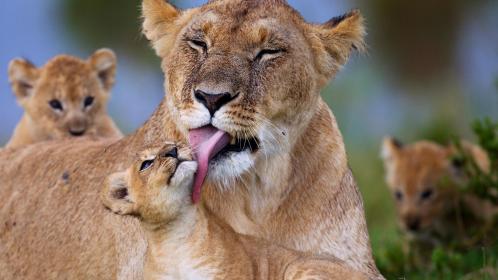
Mum, not in front of the cameras
Amateur snappers flock to Paul Goldstein’s photography safaris. Could he help Sarah Marshall get the perfect shot?
Paul Goldstein, our expert guide on this nine-day photography safari in Kenya, has been firing a volley of shots — and insults — as we track a family of hungry cheetahs through the Masai Mara Conservancies.
Today, I can’t get anything right: I’ve “minced” too much with my camera settings; I dared utter the term “big five”; and I even had the audacity to be stung by a bee, delaying our afternoon game drive by half an hour. “What are you doing?” Paul says as I turn my back on the big cats to take a safe shot of a static lilac-breasted roller. He grabs my camera and presses delete.
Our patience is rewarded with a chaotic, pulse-racing chase, as five cheetahs dart across the plains in pursuit of a startled impala
I’m quickly realising this tour is no run-of-the mill, tick-box safari. My fellow travellers look on sympathetically; they’ve all been here before. “I was gobsmacked to begin with at his impatience, jokes and hysterics over people wanting meals or lavatory trips,” reveals prim and proper Judith, leaning over to pat my hand reassuringly. “But I’ve got used to that.” Like most of the 12 guests on our tour, she’s travelled with Paul many times. Some die-hard groupies have clocked up a wallet-shredding 20 trips each.
Aside from having enduringly thick skins, they all share one thing — the ability to take astonishingly good photographs. And I’d like to go home with a bit of that, too.
Kenya’s conservancies — private, community-owned land, some of which borders the national reserve — are the perfect training ground to hone those skills. No day-trippers are allowed, and a lower vehicle density (a maximum of five per wildlife sighting) makes for a more comfortable experience all round.

Learning the trade: lining up the perfect shot takes skill and precision
We split our stay between two of the excellent Kicheche bases: Mara Camp, in the Mara North Conservancy, and Bush Camp, in the Olare Motorogi Conservancy. Solar panels, bucket showers and community-outreach programmes make these two of the most ethically sound setups in the Mara.
Any seasoned wildlife photographer knows the best hours for shooting are at dawn and dusk, so we head out before sunrise (there are no time restrictions in the conservancies) in search of our subjects. A pride of lions glide slowly through swathes of pink-tinged grass. As two frolicking cubs tumble into frame, Paul orders us to seize “the moment”.
For all his straight talking and devilish humour, Paul, 54, is irrepressibly enthusiastic — and he’s not afraid to bestow praise when it’s due. When, to my amazement, I nail a shot on day three, he’s genuinely complimentary. From a harsh critic, I’m learning, such things are all the more valuable.
Part of Paul’s winning approach is to put his guests in the right place at exactly the right time. Kicheche’s guides deftly manoeuvre the vehicles into perfect picture-taking position. This is demonstrated when we witness cheetah Malika (Paul is on first-name terms with all his animal residents) training her cubs to hunt.

Hours after other safari groups have disappeared for lunch, our patience is rewarded with a chaotic, pulse-racing chase, as five cheetahs dart across the plains in pursuit of a startled impala.
“C’mon, c’mon,” Paul screams, shaking his fists like a frenzied football supporter. He’s probably seen it all a million times, but his excitement never diminishes and it’s hard not to be swept along by his exhilaration. Seconds later, I’m staring at prey and pursuers straight down the barrel of my lens.
Later that evening, during our excruciating show-and-tell sessions, I nervously present my shot. “Good, but shame it looks a bit like Wimbledon,” our master says, referring to the short, grazed grass, which, admittedly, does resemble a tennis court.
This just fuels my determination, and I vow not to give up. That’s especially true on our final game drive, when marauding clouds gather above the Mara. As spears of rain begin to fall, our family of cheetahs return to play kickabout with a scrub hare. “Look at those losers going back to their hermetically sealed lodges,” Paul says, pointing to a few 4x4s sensibly heading home. With rain soaking through my clothes and camera gear, I wonder if I’m in the wrong vehicle.
But I’m not.
Aside from all the technical know-how and expensive kit, being a good wildlife photographer is about capturing those moments — intimate and extreme — when nature is at its most powerful and the world feels refreshingly alive. That’s not something you’ll find while truffling around the breakfast buffet.
With several respectable shots under my belt, I leave Kenya with my pride intact. In the past week, I’ve been insulted, angered, enlightened and amused. Call me a masochist, but I’d be first in line to do it all again.
[ssba]
